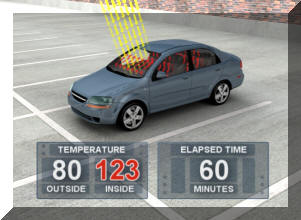

Never leave children, disabled adults or pets in parked vehicles during extreme heat
Each year, dozens of children and untold numbers of pets left in parked vehicles die from hyperthermia. Hyperthermia is an acute condition that occurs when the body absorbs more heat than it can handle. Hyperthermia can occur even on a mild day.
Studies have shown that the temperature inside a parked vehicle can rapidly rise to a dangerous level for children, pets and even adults. Leaving the windows slightly open does not significantly decrease the heating rate. The effects can be more severe on children because their bodies warm at a faster rate than adults.
The atmosphere and the windows of a car are relatively transparent to the sun’s shortwave radiation and are warmed little. This shortwave energy, however, does heat objects it strikes. For example, a dark dashboard or seat can easily reach temperatures in the range of 180°F to more than 200°F. These objects heat the adjacent air by conduction and convection and give off longwave radiation (infrared), which efficiently warms the air trapped inside a vehicle. Learn more about excessive heat and cars.
Safety tips concerning children in cars
-
Make sure your child's safety seat and safety belt buckles aren't too hot before securing your child in a safety restraint system, especially when your car has been parked in the heat.
-
Never leave your child unattended in a vehicle, even with the windows down.
-
Teach children not to play in, on, or around cars.
-
Always lock car doors and trunks--even at home--and keep keys out of children's reach.
-
Always make sure all children have left the car when you reach your destination. Don't ever leave sleeping infants in the car.
General safety tips for adults in extreme heat
-
Slow down. Reduce, eliminate or reschedule strenuous activities until the coolest time of the day. Children, seniors and anyone with health problems should stay in the coolest available place, not necessarily indoors.
-
Dress for summer. Wear lightweight, light-colored clothing to reflect heat and sunlight.
-
Put less fuel on your inner fires. Foods, like meat and other proteins that increase metabolic heat production also increase water loss.
-
Drink plenty of water, non-alcoholic and decaffeinated fluids. Your body needs water to keep cool. Drink plenty of fluids even if you don't feel thirsty. Persons who have epilepsy or heart, kidney or liver disease, are on fluid restrictive diets or have a problem with fluid retention should consult a physician before increasing their consumption of fluids. Do not drink alcoholic beverages and limit caffeinated beverages.
-
During excessive heat periods, spend more time in air-conditioned places. Air conditioning in homes and other buildings markedly reduces danger from the heat. If you cannot afford an air conditioner, go to a library, store or other location with air conditioning for part of the day.
-
Don't get too much sun. Sunburn reduces your body's ability to dissipate heat.
-
Do not take salt tablets unless specified by a physician.
Heat-related illness symptoms and first aid
HEAT CRAMPS
- Symptoms:
- Painful muscle cramps and spasms usually in legs and abdomen
- Heavy sweating
- First Aid:
- Apply firm pressure on cramping muscles or gentle massage to relieve spasm.
- Give sips of water, if nausea occurs, discontinue water
HEAT EXHAUSTION
- Symptoms:
- Heavy sweating
- Weakness
- Cool, pale, clammy skin
- Weak pulse
- Possible muscle cramps
- Dizziness
- Nausea and vomiting
- Fainting
- Normal temperature possible
- First Aid:
- Move person to a cooler environment
- Remove or loosen clothing
- Apply cool, wet cloths
- Fan or move victim to air conditioned room
- Offer sips of water. If nausea occurs, discontinue water. If vomiting continues, seek immediate medical attention.
HEAT STROKE (or sunstroke)
- Symptoms:
- Altered mental state
- Possible throbbing headache, confusion, nausea, dizziness, shallow breathing
- High body temperature (106°F or higher)
- Skin may be hot and dry, or patient may be sweating
- Rapid pulse
- Possible unconsciousness
- First Aid:
- Heat stroke is a severe medical emergency. Summon emergency medical assistance or get the victim to a hospital immediately. Delay can be fatal.
- Move the victim to a cooler, preferably air-conditioned, environment
- Reduce body temperature with a water mister and fan or sponging
- Use fan if heat index temperatures are below the high 90s
- Use extreme caution
- If temperature rises again, repeat process
- Do NOT give fluids
Source: National Oceanic and Atmospheric Administration (NOAA)
Published 7-18-14